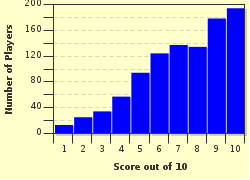Quiz Answer Key and Fun Facts
1. In many cases, one of the first objects of interest seen by the visitor to an English country church will be the lych-gate, a porch-like gateway giving access to the churchyard. What is the original meaning of the word "lych"?
2. Still outside the church, the visitor might look up to the roof and see a grotesque carving of a strange creature with a water-spout protruding from its mouth. What is the general term for this object?
3. What objects, found in most English country churches but not always visible to the casual visitor, may have been manufactured by companies by the name of Alfred Bowell, Thomas Mears II, and John Taylor (among many others)?
4. On entering an English country church, one of the first things the visitor sees may be a font. What would a font normally be used to hold?
5. A Rood Screen is the traditional name for the dividing screen, usually wooden and elaborately carved, between the nave and the chancel of the church. Why was it given this name?
6. By the altar, the visitor may see an object known as a thurible. What exactly is this used for?
7. The visitor may also wish to view the reredos, examples of which are often elaborately decorated. But where in a church would you look to find this object of interest?
8. The visitor will often notice thick cushions, often beautifully hand-decorated in needlework, hanging from the backs of the pews. Known as "hassocks", what is their intended purpose?
9. Churches don't run themselves, of course, and a number of people will be involved in their daily business. But which of the following would you NOT expect to find involved in the day-to-day life of an English country church?
10. If the visitor is able to gain entry to the vestry, he or she will usually find an assortment of vestments and other items worn by the clergy and other church officials during the services of worship. But which of these is NOT an item of clothing normally worn by Church of England clergy?
Source: Author
stedman
This quiz was reviewed by FunTrivia editor
CellarDoor before going online.
Any errors found in FunTrivia content are routinely corrected through our feedback system.


